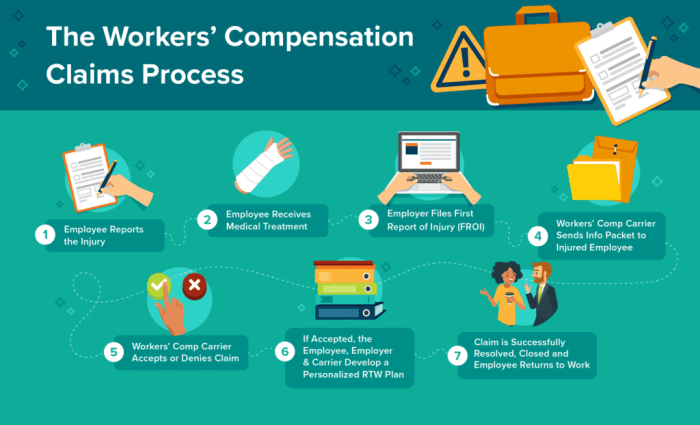
How workers’ comp works is a vital topic for both employees and employers alike, as it sheds light on the safety nets available for those who find themselves injured on the job. With a system designed to provide financial support and medical care, understanding the ins and outs of workers’ compensation can significantly impact the lives of workers navigating these challenging situations.
In this overview, we will delve into the purpose and benefits of workers’ compensation, unravel the intricacies of the claims process, and explore how diverse state laws can shape experiences around these claims. Whether you’re looking to file a claim or simply want to learn more about how this essential support system operates, you’ll find valuable insights here.
Understanding Workers’ Compensation

Workers’ compensation serves as a safety net for employees who suffer injuries or illnesses arising from their work environment. This system is designed to provide financial and medical benefits to workers, ensuring they receive the necessary support during recovery without the burden of legal battles. The primary goal of workers’ compensation is to promote workplace safety while protecting both employees and employers from potential lawsuits.The workers’ compensation process generally begins when an employee sustains an injury at work.
Once the injury occurs, the employee must report it to their employer, often within a specific timeframe defined by state law. After reporting the injury, the employer is responsible for providing the necessary medical treatment and filing a claim with their workers’ compensation insurance carrier. This claim undergoes a review process where the insurance provider evaluates the validity of the injury claim.
If approved, the employee receives benefits, which may include coverage for medical expenses and wage replacement during recovery.
Differences in Workers’ Compensation Laws Across States
Workers’ compensation laws vary significantly from state to state, reflecting different regulatory frameworks and provisions. Understanding these differences is crucial for both employees and employers to ensure compliance and optimal coverage. Below are key aspects that illustrate the variations in workers’ compensation laws:
- Benefit Structures: Each state defines its own benefit structure, including the amount of compensation and the duration for which benefits are available. For example, some states offer a higher percentage of wage replacement than others.
- Eligibility Requirements: States may have differing criteria for eligibility, influencing who qualifies for benefits. Some states require a waiting period before employees can receive benefits, while others may offer immediate compensation.
- Medical Treatment Guidelines: Guidelines for medical treatment and the selection of healthcare providers can differ. Certain states allow employees to choose their own doctors, while others may require workers to see approved healthcare professionals.
- Dispute Resolution: The process for handling disputes regarding claims also varies. Some states have formal administrative hearings, while others may suggest mediation or have limited options for appeal.
Understanding regional differences in workers’ compensation laws is vital for navigating the complexities of workplace injury claims.
Workers’ Compensation Claims Process
Filing a workers’ compensation claim can often seem daunting, but it’s essential for ensuring that injured workers receive the benefits they deserve. Understanding the steps involved can make the process smoother and less stressful.The claims process typically follows a structured path that requires timely action and accurate documentation. Workers must be aware of common challenges they may encounter and how best to address them.
By following a clear checklist and knowing the steps involved, workers can navigate through the claims process more effectively.
Steps Involved in Filing a Workers’ Compensation Claim
To ensure a successful workers’ compensation claim, the following steps should be meticulously followed:
1. Report the Injury
The first step is to inform your employer about the injury as soon as possible. Most states require this notification within a specific timeframe, often within 30 days.
2. Seek Medical Attention
It is crucial to get medical treatment for the injury. Proper documentation from a healthcare provider is essential for your claim.
3. Complete Claim Forms
After reporting the injury, you’ll need to fill out the necessary claim forms, which can typically be obtained from your employer or their insurance carrier.
4. Submit the Claim
Once the forms are completed, submit them to your employer’s workers’ compensation insurance provider.
5. Keep Records
Maintain copies of all documents submitted, including medical reports, claim forms, and correspondence with your employer or insurance carrier.
Common Challenges and Solutions
When filing a workers’ compensation claim, workers may face several challenges that can complicate the process. Being aware of these challenges and knowing how to overcome them is vital:
Delayed Reporting
One of the most significant hurdles is the delay in reporting the injury. To combat this, always report injuries immediately and keep a written record of your notification.
Incomplete Documentation
Insufficient paperwork can lead to claim denials. To avoid this, ensure that all forms are thoroughly completed and all required documents are gathered before submission.
Claims Denial
If your claim is denied, understand the reasons for denial and prepare to appeal. Gather additional evidence or documentation to support your case.
Documentation Checklist for a Successful Claim
Proper documentation is imperative in facilitating a successful workers’ compensation claim. Here’s a checklist of essential documents you need to prepare:
Incident Report
Document detailing the circumstances of the injury.
Medical Records
All reports from healthcare providers related to the injury.
Claim Forms
Completed workers’ compensation claim forms.
Witness Statements
Statements from coworkers or others who witnessed the incident.
Correspondence
Copies of any communication with your employer or insurance company regarding your claim.This checklist serves as a foundation for assembling the necessary information and can significantly impact the outcome of your claim.
Workers’ Compensation and Related Topics

The realm of workers’ compensation extends beyond just employee benefits; it intertwines with various industries and modern platforms that can influence both understanding and claims processes. Exploring these relationships can provide insights into how workers’ compensation operates within the broader economic framework while also impacting the awareness and safety practices at the workplace.
Relationship Between Workers’ Compensation and Affiliate Revenue Streams
The workers’ compensation system has a symbiotic relationship with several industries, notably insurance, healthcare, and legal services. As businesses invest in safety measures to minimize claims, they often turn to affiliates that offer safety training, ergonomic products, and workplace assessments. This creates a revenue stream that can be quite lucrative for those affiliated companies.
- Insurance Providers: Insurance companies benefit from lower claims as businesses implement better safety measures, leading to premium reductions and increased market competitiveness.
- Healthcare Services: Medical providers see a steady flow of patients requiring treatment for work-related injuries, driving revenue for clinics and hospitals that specialize in occupational health.
- Legal Firms: As workers may seek legal counsel regarding denied claims or disputes, legal experts in workers’ compensation find a constant source of clients, enhancing their profitability.
Impact of Online Platforms on Workers’ Compensation Claims
The advent of online platforms, particularly those related to the Internet and auction sites, has altered the landscape of workers’ compensation claims by providing workers with easy access to information and resources. This accessibility can lead to more informed employees who are better equipped to navigate the claims process.
- Information Accessibility: Workers can now find resources, guides, and personal stories related to workers’ compensation claims, leading to a more educated claimant pool.
- Marketplace for Legal Services: Websites that connect individuals with legal professionals allow workers to quickly find legal aid tailored to their needs, potentially increasing the number of claims filed.
- Online Reviews: The presence of online reviews and testimonials can influence a worker’s choice of medical providers or legal representation, thereby affecting the overall claims experience.
Influence of Audio Streaming Services on Workplace Safety
Audio streaming services have emerged as an unexpected ally in promoting workplace safety and awareness regarding workers’ compensation. The proliferation of podcasts and audio content focused on safety practices can enhance employee engagement and knowledge.
- Safety Training Content: Many organizations now leverage audio platforms to deliver safety training sessions, making it easier for employees to absorb crucial information.
- Awareness Campaigns: Podcasts that discuss real-life injury cases and preventive measures can raise awareness around workers’ compensation, prompting proactive safety measures.
- Community Building: Audio platforms can foster discussions about workplace safety, encouraging employees to share experiences and learn from one another, thus creating a culture of safety.
“The integration of modern platforms into workers’ compensation highlights the dynamic nature of workplace safety and employee rights, creating a more informed and engaged workforce.”
Summary
In summary, understanding how workers’ comp works can empower you to navigate the complexities of workplace injuries with greater confidence. From the initial claim filing process to the varying laws by state, knowledge is key to ensuring workers receive the support they deserve. As we continue to explore the relationship between workers’ compensation and broader industry trends, it becomes clear that awareness and education are vital for fostering a safer workplace for everyone.
Question & Answer Hub
What is workers’ compensation?
Workers’ compensation is a form of insurance that provides financial and medical benefits to employees who are injured or become ill as a direct result of their job.
Who is eligible for workers’ compensation?
Generally, most employees are eligible for workers’ compensation, including part-time and full-time workers, as long as their injury occurred in the course of employment.
How long do I have to file a workers’ comp claim?
The time limit to file a workers’ compensation claim varies by state, but it typically ranges from 30 to 90 days after the injury occurs.
Can I sue my employer if I receive workers’ compensation?
In most cases, if you receive workers’ compensation benefits, you cannot sue your employer for the same injury, as workers’ comp is usually the exclusive remedy for workplace injuries.
What should I do if my claim is denied?
If your claim is denied, you should review the denial letter, gather any additional necessary documentation, and consider appealing the decision or seeking legal assistance.







